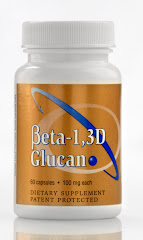The Immune Response Enhanced by Beta-1,3D Glucan by A.J.Lanigan - pg.1
The immune response begins when invaders like viruses enter the body. White blood cells, called macrophages, encounter the invader and consume it. The macrophage does not care what the invader might be. It only knows self or non-self. Meanwhile, other viruses look for nearby cells to infect. Beta-1,3D Glucan, an extract from the cell wall of a baker's yeast, turns the "Woody Allen cells" into "Schwartzenagger cells." This allows your immune system to be "all that it can be". Beta-1,3D Glucan modulates and potentiates the macrophage and keeps it in a more prepared state. With this balancing effect, all subsequent immune response improves. The beta glucan and the macrophages are oblivious to the type of invader or the health of the host. Again, the macrophage only knows self vs. non-self. The glucan treated host will enjoy an increase in its arsenal against unwanted offenders.
Next, the macrophage digests the virus and displays pieces of the virus (antigens) on its surface. Antigens may be any substance introduced into the body that the immune system recognizes as non-self. Nearby cells may become infected by the attacking viruses. In a healthy immune system, these infected cells will come under attack, be destroyed, and be removed before they can be used to spread the illness.
Unique among the different helper T cells (another class of white blood cells) in the body, one particular helper T cell now recognizes the antigen displayed and binds to the macrophage. There are at least two subsets of the helper T cells, the Th1 and the Th2. They make the decisions as to what type response will be ordered. Up and down regulatory factors transmitted by this pair of cells (macrophage + T helper) provide many variations for dealing with the invaders.
This union stimulates the production of chemical substances - such as interleukin-1 (IL-1) and tumor necrosis factor (TNF) by the macrophage, and interleukin-2 (IL-2) and gamma interferon (IFN-y) by the T cell - that allow intercellulor communication. Theses cytokines/lymphokins (fax messages) are required for T cell activation and response. Mere activation is not enough. The Antigen Presenting Cell (APC), depending on the type (MHC I or II) of presentation gives co-stimulation (a second go-ahead signal). CD28 (blood test) reflects this co-stimulation and activation process. - source
Showing posts with label IL-1. Show all posts
Showing posts with label IL-1. Show all posts
Saturday, September 26, 2009
The Immune Response Enhanced by Beta-1,3D Glucan - pg.2
The Immune Response Enhanced by Beta-1,3D Glucan by A.J.Lanigan - pg.2
As part of the continuing process, IL-1 helps activate B and T cells; IL-2 instructs other helper T's and a different class of T cells, the killer T's (CTLs or cytotoxic T lymphocytes), to multiply. The proliferating helper T's in turn release substances that cause B cells to multiply and produce antibodies. B cells are prepared to recognize antigen without preprocessing. The T cell cannot recognize antigen in its natural state. It must first be broken down and the fragments bound to a Major Histocompatibility Complex (MHC) molecule by the APC. The macrophage is an APC. Glucan causes its receptor sites (key slots) to be released for these presentation chores.
The killer T cells (trained assassins) now begin shooting holes in cells that have been infected by viruses or other pathogens. The killer T cell (CTL or cytotoxic T lymphocyte) becomes a "trained assassin". They respond to the MHC I complex, which is found on almost all body cells. The CTL has the ability to seek and destroy infected human cells in a specific manner. With the injection of powerful chemicals, these infected cells are killed before they can be used to spread a disease. Natural Killer (NK) cells are large, granule-filled lymphocytes that take on tumor cells and infected body cells. They are known as "natural" killers because they attack without first having to recognize specific antigens. Like the macrophage, if it is not "self", it will proceed to kill. NK cells and CTLs both kill on contact. The killer binds to the target, aims its weapons and then releases a lethal burst of chemicals to punch holes in the target. - source
As part of the continuing process, IL-1 helps activate B and T cells; IL-2 instructs other helper T's and a different class of T cells, the killer T's (CTLs or cytotoxic T lymphocytes), to multiply. The proliferating helper T's in turn release substances that cause B cells to multiply and produce antibodies. B cells are prepared to recognize antigen without preprocessing. The T cell cannot recognize antigen in its natural state. It must first be broken down and the fragments bound to a Major Histocompatibility Complex (MHC) molecule by the APC. The macrophage is an APC. Glucan causes its receptor sites (key slots) to be released for these presentation chores.
The killer T cells (trained assassins) now begin shooting holes in cells that have been infected by viruses or other pathogens. The killer T cell (CTL or cytotoxic T lymphocyte) becomes a "trained assassin". They respond to the MHC I complex, which is found on almost all body cells. The CTL has the ability to seek and destroy infected human cells in a specific manner. With the injection of powerful chemicals, these infected cells are killed before they can be used to spread a disease. Natural Killer (NK) cells are large, granule-filled lymphocytes that take on tumor cells and infected body cells. They are known as "natural" killers because they attack without first having to recognize specific antigens. Like the macrophage, if it is not "self", it will proceed to kill. NK cells and CTLs both kill on contact. The killer binds to the target, aims its weapons and then releases a lethal burst of chemicals to punch holes in the target. - source
Subscribe to:
Posts (Atom)



